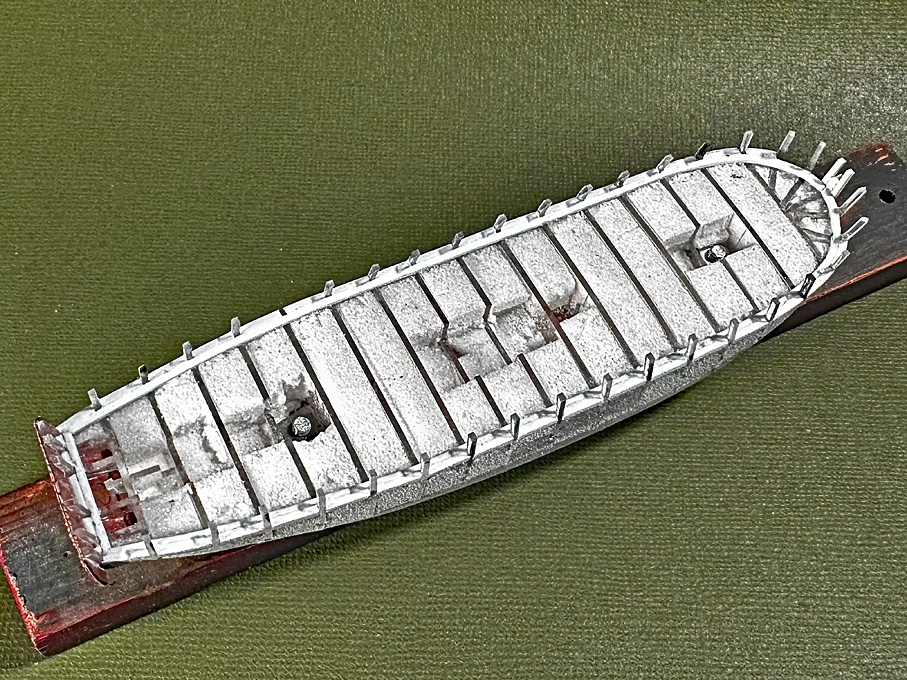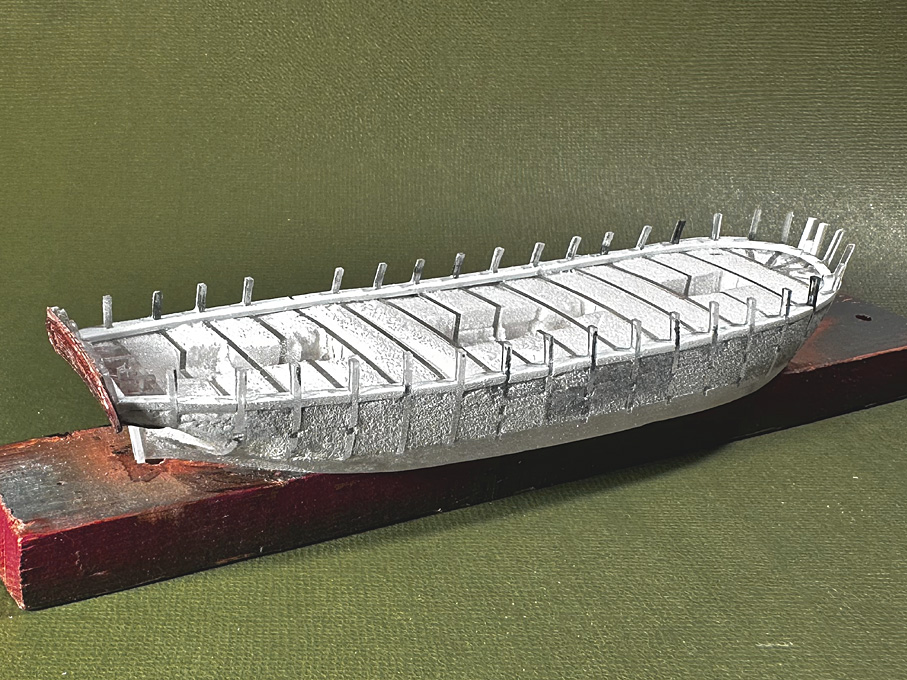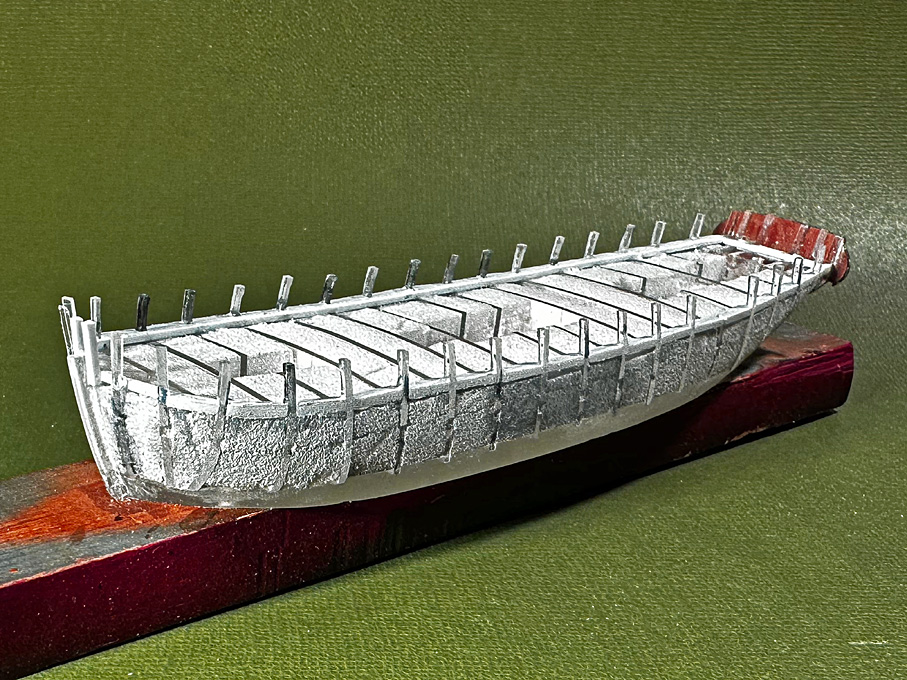-
Posts
6,547 -
Joined
-
Last visited
Content Type
Profiles
Forums
Gallery
Events
Everything posted by wefalck
-
Didn't I send you at some stage a list of all the drawings that pertain to JYLLAND from the archives of the Danish Navy Shipyard? Basically, archival Nos. G1859 to G1896 pertain to her, including a rigging plan (G1872 and G1873). There are additional mast details at G4882 to G4900. The mast actually look surprisingly vertical.
-
Slow Progress (as usual) The run of the planking and their layout will be determined by three structural members, namely the rail on the bulwark as upper edge, the covering board, which marks the lower edge of the bulwark and the upper edge of which is marked in the original drawings, and the wales, the upper edge of which are also marked in the original drawings. In order to physically define the top edge of the covering board, the waterways have to be installed first. The consist of a 1 mm x 1 mm styrene strip running along the inside of the bulwark stanchions. This is thicker than the actual water ways would be, but the thickness includes that of the covering board inside the bulwark stanchions. The space between the stanchions was filled with small pieces of 1 mm x 1.5 mm styrene strip. This is a tad wider than needed, but allows me to sand them down to the actual profile outside of the stanchions. While in theory the stanchions are spaced equidistant, the filling pieces still required a bit of sanding to fit them snuggly. There are actually many different designs for the waterway/covering board arrangement and not any particular construction method is being followed here. The idea is to give the right visual impression after painting, not to follow prototype construction method. In fact, it would have been rather difficult to cut out the notches for the stanchions from the styrene strip representing the covering board at these dimensions, as would have been the prototype method. The arrangement will be completed by a 0.5 mm x 0.75 styrene strip that will be shaped to a half-round profile using a scraper fashioned from a piece of razor-blade and that will be cemented along the upper edge of the covering board. To be continued
-
The problem is that people confuse 'materials' with 'applications'. A lot of materials can be used for the same application and a lot materials can be used for different applications. Shellac can be used as a cement, as a varnish, as a binder in paints (with pigments added), as sanding sealer (with pumice added), for seals, etc. etc. I fully agree and have repeatedly said so in this forum, that mixing varnish- and paint-systems can lead to trouble unless you really know what you are doing.
-
Not sure, why people differetiate between shellac and 'varnish'. Shellac can be used as a varnish among other applications. A varnish consists of some material that form a continuous coating, e.g. a resin or a oxidising oil, and a solvent that allows to apply this material and vaporises after application.
-
Are the engine service-doors already glued in? Otherwise you could leave them open to give a glimpse of the engines ...
- 732 replies
-
- Lula
- sternwheeler
-
(and 1 more)
Tagged with:
-

Harriet McGregor by Boccherini
wefalck replied to Boccherini's topic in - Build logs for subjects built 1851 - 1900
Do you have Underhill's 'Masting and Rigging ...'? That should give you the detailed information for that period. -
Sometimes repairs can make things worse ... are these digs and dents very obvious? If they blend into the general rougher look of those boats, I would leave them like they are, particularly, when the areas are to be painted anyway.
- 312 replies
-
- Chile
- Latin America
-
(and 6 more)
Tagged with:
-
I have had a similar experience (albeit at a much smaller scale and physical size). I found that the prints came out 0.5% too small in x and y. So I am now creating a duplicate layer in my 2D-CAD in which I place the items to be printed and scale them at 100.5%. You can always check the measure of the printout with the theoretical value in the CAD-drawing.
-
Distant diagnoses are always tricky, but I would cut the deck-sheet to size, rub it downs somewhat with sandpaper, apply sanding sealer, rub it down again with fine sandpaper, another coat of sanding sealer, and finally rubbing with fine (0000) steel-wool. That should give you thin sheets of decking with a satin finish, ready to be glued into place.
-
According to the 2nd Law of Thermodynamics everything will crumble away sooner or later - unless one spends energy and material on its upkeep (restoration is quasi periodic upkeep). I agree that it is not so easy to find good quality paper and cardboard. I quite like Bristol-board, which is a wood- and acid-free cardboard that has a smooth calandered (rolled) surface. It is even more difficult to find very thin calandered paper - I have been hoarding supplies that came to me from deceased relatives and that may well be 60, 80, or even 100 years old. Ab, as restorer is certainly painfully aware of this, that certain materials are simply not made anymore, because they are not used anymore or would be used only in such small quantities that it doesn't pay to make them. For instance I have been hunting down all over Europe a type of extremly fine and firm two-ply thread that was once used to darn ladies' stockings. Nobody bothers with mending stockings anymore, at least not with the old-time nearly invisble darning techniques, so that these yarns have disappeared from the market. Sorry, I am digressing ...
- 77 replies
-
- Royal Yacht
- card
-
(and 1 more)
Tagged with:
-
But there are wood- and acid-free carboards these days. OK they are more expensive. I remember at least one art shop in Alkmaar that sells them.
- 77 replies
-
- Royal Yacht
- card
-
(and 1 more)
Tagged with:
-
Indeed these parts look excellent and one would have quite a time to make them from styrene strips etc. so consistently and with the 'drafts' as on real cast parts. 3D-printing is the future of high-end scratch-building ... I am a bit confused that you mentioned PLA as material together with SLA as printing technique. I thought that PLA is only used together with filament printers (FDM), but the parts look actually as done with a SLA printer.
-
Sure, a model with shiny brass guns can show off good handcraft. I you want to stay them like that, you can brush them in zapon-varnish as used to protect silver-ware. Otherwise, it is a question, whether the prototype was bronze, cast-iron or (later) steel. At all times guns were not left to themselves, but various methods of corrosion protection where applied. The archetypal black colour, of course, comes from black paint as applied mostly to cast-iron guns. Bronze guns were given what the artists would call a patina. There is a wide range of recipes for that, resulting in a slightly metallic brown or dark green. The bright green as seen on coppered roofs is a sign of corrosion and would not be seen on guns in service. Cast-iron and steel-guns in some navies were also rubbed down with vinegar, which resulted in the formation of 'rust', actually in this case ferric acetate mixed with ferric oxyhdrate. This rust layer then was solidified by rubbing it with lineseed oil. De facto one created a dark reddish brown paint (like caput mortuum) in situ, protecting the gun from further corrosion. In later years, when breech-loading steel guns were introduced, the vinegar method could have damaged the mechanism, so brown paint of a similar appearance was used instead.
-
I must admit, I only occassionally browse MSW for new projects, so I missed the start of this one ... it coming along nicely! Talking about rivetted boilers: my choice would have been to clad the boiler in thin copper or aluminium foil into which the 'rivets' have been embossed with a pounce-wheel. To do this I put the sheet on a piece of linoleum or a cutting mat and run down the wheel in the desired pattern. Then I turn the sheet over and push back the pimples lightly with a short piece of round dowel. This reduces the distortion from the pounce-wheel and at the same time makes the 'rivets' looking better defined. I didn't look into the construction of Scotch boilers, but would think at the boiler ends these are not rivets, but the screws from the boiler stays? And I learned something about sternwheelers today: in Keith's LULA project I wondered why they used the more complex valved engine (e.g. Corliss) and not the much simpler sliding-valve version as in most locomotives. Your description made me realise, that the excenter would have to be placed on the axle of the wheel, resulting in a very long connecting rod. The weight of that would cause a lot of wear on the glands of the steam-box for the sliding-valve. So while a Corliss-engine is a much more delicate machine in-board, it reduces the out-board parts to the pitman-arm and its crank. 💡
-
Mexico certainly is a more developed country than many African and perhaps South Asian countries, and has access to the materials for making GRP hulls. I would probably now stain the deck, then apply sanding filler all over before sanding with finer paper.
- 312 replies
-
- Chile
- Latin America
-
(and 6 more)
Tagged with:
-
Thanks for the link above. I think I should try to get hold of a copy of the 'Pyle', though you confirmed my suspicion that the drawings wouldn't be too detailed. I have been on various trips from Anegada down to the Grenadines, but not on all islands between the early 1990s and the early 2000s. At that time there were still quite a few wooden sailing-boats and canoe-like boats around. Unfortunately, the FAO caused havoc from the 1950s on to the tradtional boats all over the world, because they were considered inefficient. They promoted standardised GPR-boats based on modern North-American models and equipped with outboard engines. In many regions they seem to have been in use long enough to kill much of the local skills in boatbuilding. However, I have seen people returning to the tradtional craft, because they were cheaper to maintain and one could do so using local materials, skills, and infrastructure. A holed GPR-boat is not so easy to fix, if you don't have access to the resins, matts etc.
- 312 replies
-
- Chile
- Latin America
-
(and 6 more)
Tagged with:
-
The question is also does one really need to 'protect and finish' painted areas? On a display model, this may not be really needed. The only reason I can see why one wants to varnish a previously painted area is that one wants to have a uniform sheen. However, on a real ship surfaces treated differently would have a different sheen. Many modellers simulate surfaces that on a real ship would have been treated with wood-tar by leaving the wood 'bare' and only varnish it. Or they want to emulate the look of historic models, where the wood would have been varnished or oiled. In this case I would first varnish the whole model and then paint the areas that would have been painted. Beware that acrylics are probably not sticking well to oiled surfaces, even when oxidising oils, such as lineseed or tung oil have been used.
-
It's more physics than chemistry here. Shellac and acrylic paint may have different thermal expansion coefficients. So, depending on the thickness of the respective layers, they may shrink or expand differently, leading to crackelure. You also can crackelure, when the outer layer shrinks while drying. This can make the inner layer even lift off the surface. And yes, chemistry can also play a role, particularly when painting with a brush, where layers tend to be thicker than when airbrushing, which means that you bring more solvent to the first layer of paint that can react with this paint. In general, like with like adheres better. However, I agree there may be situations where you want to use shellac on acrylics. Say when you try to simulate varnished wood with paint and want to get the same kind of sheen as with shellac. However, I would in any case try with acrylic varnish and see what it looks like.
About us
Modelshipworld - Advancing Ship Modeling through Research
SSL Secured
Your security is important for us so this Website is SSL-Secured
NRG Mailing Address
Nautical Research Guild
237 South Lincoln Street
Westmont IL, 60559-1917
Model Ship World ® and the MSW logo are Registered Trademarks, and belong to the Nautical Research Guild (United States Patent and Trademark Office: No. 6,929,264 & No. 6,929,274, registered Dec. 20, 2022)
Helpful Links
About the NRG
If you enjoy building ship models that are historically accurate as well as beautiful, then The Nautical Research Guild (NRG) is just right for you.
The Guild is a non-profit educational organization whose mission is to “Advance Ship Modeling Through Research”. We provide support to our members in their efforts to raise the quality of their model ships.
The Nautical Research Guild has published our world-renowned quarterly magazine, The Nautical Research Journal, since 1955. The pages of the Journal are full of articles by accomplished ship modelers who show you how they create those exquisite details on their models, and by maritime historians who show you the correct details to build. The Journal is available in both print and digital editions. Go to the NRG web site (www.thenrg.org) to download a complimentary digital copy of the Journal. The NRG also publishes plan sets, books and compilations of back issues of the Journal and the former Ships in Scale and Model Ship Builder magazines.






